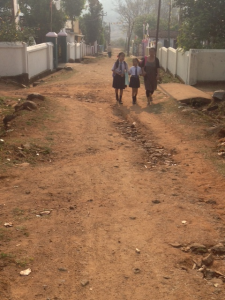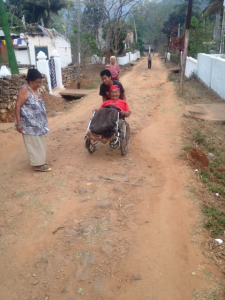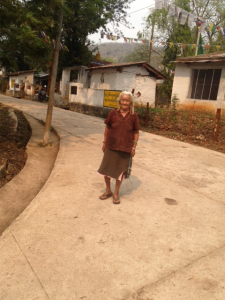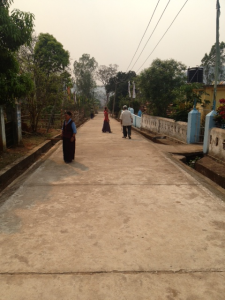Thursday
Shambhala News ServiceLife in Orissa
by Sarah Sutherland, Regional Secretary to the Sakyong Wangmo
Fifty years ago this May, Tibetan refugees fleeing political turmoil and religious persecution first arrived in the Chandragiri valley of Orissa — a remote corner of India. Since then, the Ripa family lineage has taken its seat there and thrived. Today, more than 4,000 community members live in five settlement camps collectively known as Phuntsokling and nearly 400 monks practice in the magnificent Rigon Thupten Mindroling monastery.
In advance of this anniversary, the Shambhala Times spoke with the Sakyong Wangmo, who reflected on her experience of growing up in Orissa, where her father and uncle guided and nurtured the spiritual and physical well being of the Tibetan community. The Sakyong Wangmo also shared her thoughts about Phuntsokling today, especially her aspiration to improve the quality of life there by helping to complete construction of much-needed roads between the settlement camps.

Before the road project, school children and the elderly traveled the unpaved roads in Phuntsokling with difficulty.
“My family came from the cold, mountainous region of Kham in eastern Tibet,” she continued, “which I consider my ancestral home. I, however, was born in the warm, tropical state of Orissa, whose sights and smells are very much part of my childhood.”
“Though my family resides in a compound near Rigon Thupten Mindroling, I know very well the hardships the villagers face, particularly during monsoon season,” the Sakyong Wangmo said. “The roads turn to mud, making it dangerous for people to travel between camps. Some people drive, risking accidents, but many people walk and need to transport their animals along these roads. It’s very unsanitary. Even worse, the heavy rains can’t drain properly, so water builds up and floods into people’s homes. Unfortunately, the lack of drainage also leaves huge pools of water along the road, where mosquitoes breed. For people walking on the roads and living nearby, these conditions make them vulnerable to contracting malaria.”
 In fact, with the largest number of malaria patients and deaths due to malaria, Orissa has the ignoble title of “malaria capital” of India. (According to the Ripa Ladrang Foundation, which oversees the Malaria Prevention Fund, malaria is the most common health problem and cause of mortality among the residents of Orissa.)
In fact, with the largest number of malaria patients and deaths due to malaria, Orissa has the ignoble title of “malaria capital” of India. (According to the Ripa Ladrang Foundation, which oversees the Malaria Prevention Fund, malaria is the most common health problem and cause of mortality among the residents of Orissa.)
Today, thousands of Tibetans of all ages travel between the camps, which are four to five kilometers apart, to reach the school, hospital, monastery and merchants. When the roads are not wet and muddy in the summer, they are often dry and cracked in the winter, making travel and life difficult.
Fortunately — thanks to a project funded by the Sakyong Foundation — the road to camp 2 is now concrete and includes proper drains and culverts. Inspiration for this road project blossomed in 2006 at the Royal Wedding in Orissa, where Tibetans and Westerners gathered to celebrate the marriage of the Sakyong and Sakyong Wangmo and the joining of the Shambhala and Ripa lineages. Pledges made at that time by students and supporters of the Sakyong and Sakyong Wangmo enabled the Sakyong Foundation to grant $80,000 to the road project in 2008.

After the new road and culverts were built, the quality of life at settlement camp 2 improved greatly.
But with the roads to four other settlement camps still unpaved and hazardous, work remains.
Inspired to further the road construction, the Sakyong Wangmo has initiated a fund to help support this and other humanitarian projects that improve living conditions for Tibetans in exile.
Called the Sakyong Wangmo Fund, the Sakyong Wangmo’s endeavor rests under the auspices of the Sakyong Foundation. All funds raised will be directed toward projects that the Sakyong Wangmo believes will benefit the well being of the Tibetan community, such as building roads between the settlement camps of Phuntsokling.
Despite its name — which means “the land of happiness and plenty” — Phuntsokling is not entitled to receive any Indian government-run social development aid or programs due to its status as a refugee community. (The Central Tibetan Administration, which is the Tibetan government in exile based in Dharmsala and led by His Holiness the Dalai Lama, oversees the welfare of Tibetan refugees in India and elsewhere.)
 The Ripa family and its monastic and lay communities settled in Orissa decades ago — and many more thousands of Tibetans made their homes in five other settlements in India. Most improvements in the settlement camps are made by individual families or are undertaken by the monastery. At Rigon Thupten Mindroling, Jigme Rinpoche directs the Pure Water Project as well as sponsorship programs for monks and the elderly. For the most part, however, there are very few projects to improve public infrastructure.
The Ripa family and its monastic and lay communities settled in Orissa decades ago — and many more thousands of Tibetans made their homes in five other settlements in India. Most improvements in the settlement camps are made by individual families or are undertaken by the monastery. At Rigon Thupten Mindroling, Jigme Rinpoche directs the Pure Water Project as well as sponsorship programs for monks and the elderly. For the most part, however, there are very few projects to improve public infrastructure.
As a result, the road project the Sakyong Wangmo aspires to fund — which would minimize accidents, improve sanitation and reduce malaria — would be a considered a significant humanitarian accomplishment. And such a gesture is sure to be felt not only by the people in Phuntsokling but by the entire Tibetan community in exile, from Orissa to Dharmsala.
“In my role as Earth Protector and lineage holder, I feel a deep responsibility to help guard and preserve the wisdom of the Tibetan culture,” said the Sakyong. “Please join the Sakyong Wangmo and myself in this humanitarian effort.”
Plans for constructing a new road at camp 5 are now underway. Watch for more news on the road project and the Sakyong Wanmgo Fund in the coming months.
Please consider making a gift towards the completion of the four roads and drainage systems in Phuntsokling. Donations can be made online at: www.sakyongfoundation.org/chandragiri
“I am so happy that the Sakyong will be hosting a special benefit dinner to initiate the Sakyong Wangmo Fund at The Sakyong Foundation when he is teaching on Shambhala Meditation in Boulder in June. Please join in to celebrate and support this cause.” – the Sakyong Wangmo
If you would like more information about the benefit dinner hosted by the Sakyong on June 30, or to reserve a place at the event, please contact Jane Vosper at [email protected].
~~
Click below for more information on:
The Sakyong Foundation’s grant to the Orissa road project.
The Ripa Lagrang Foundation’s Malaria Prevention Fund
The Pure Water Project.





